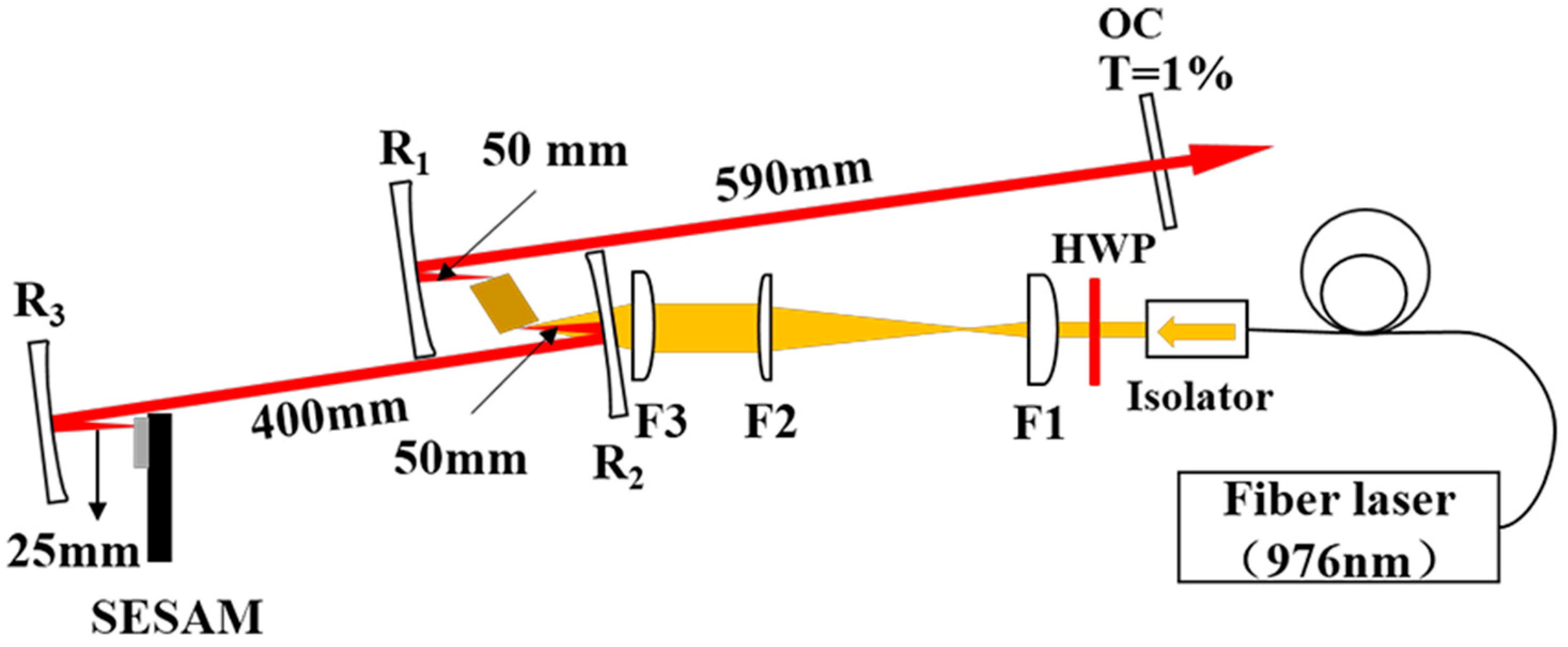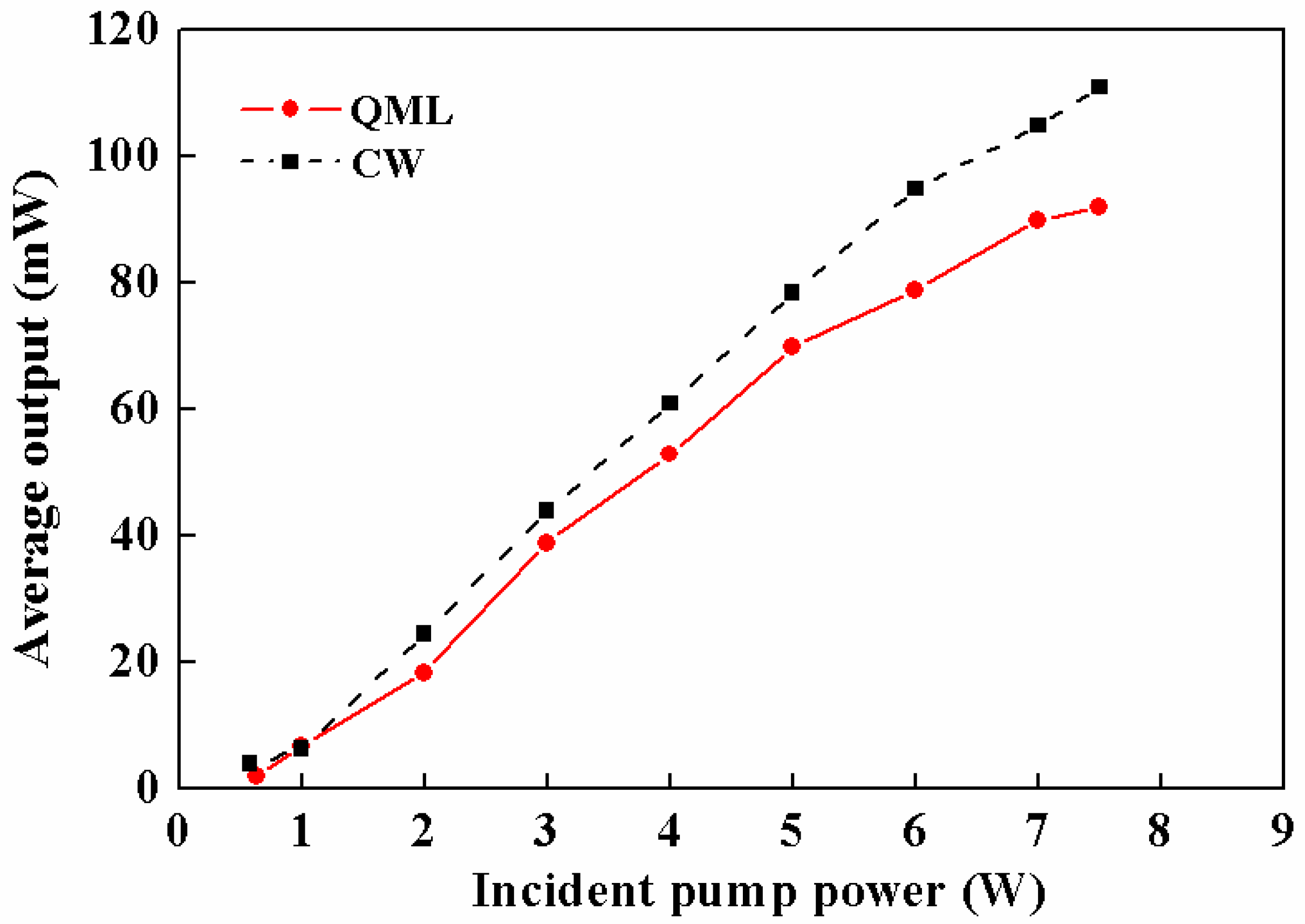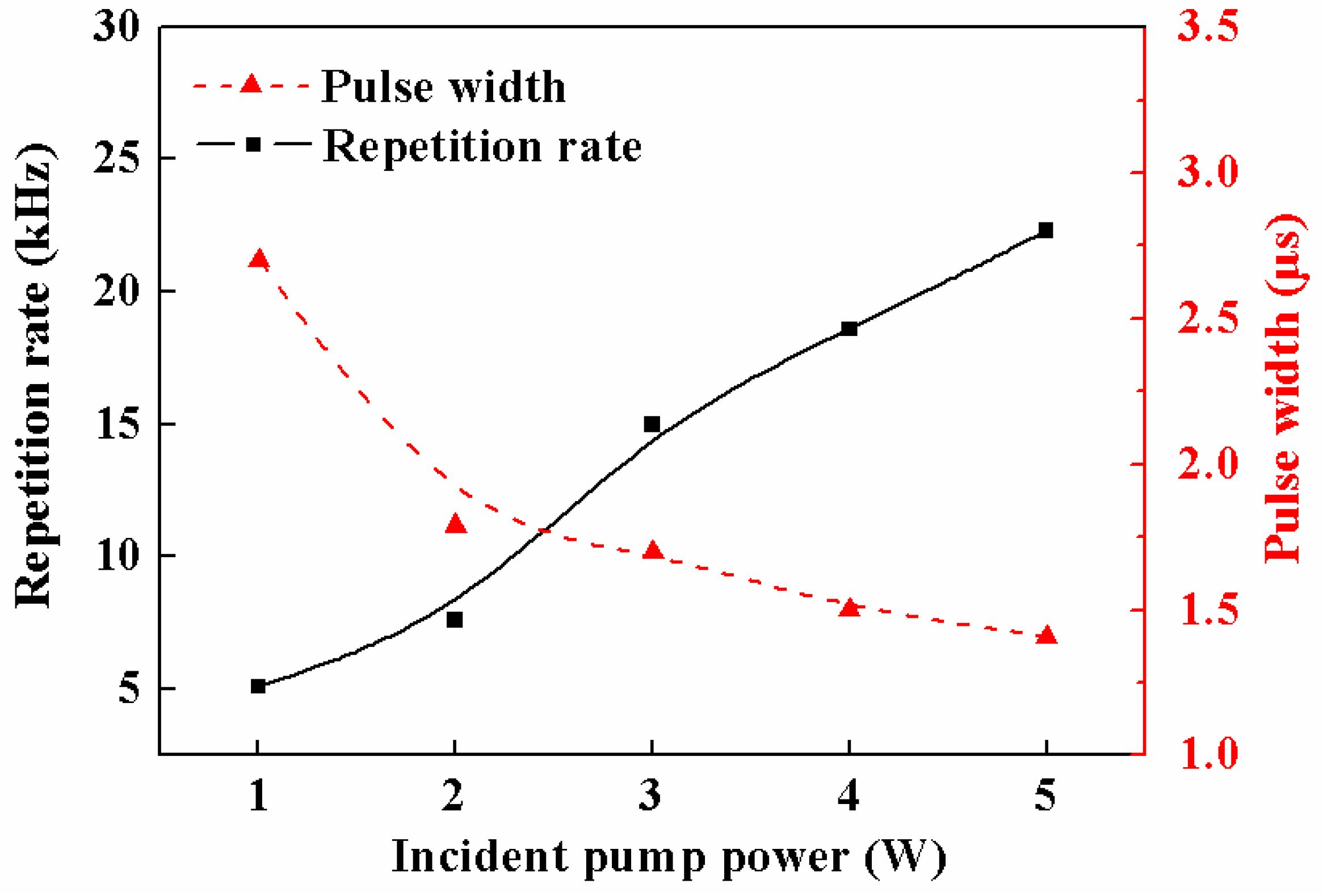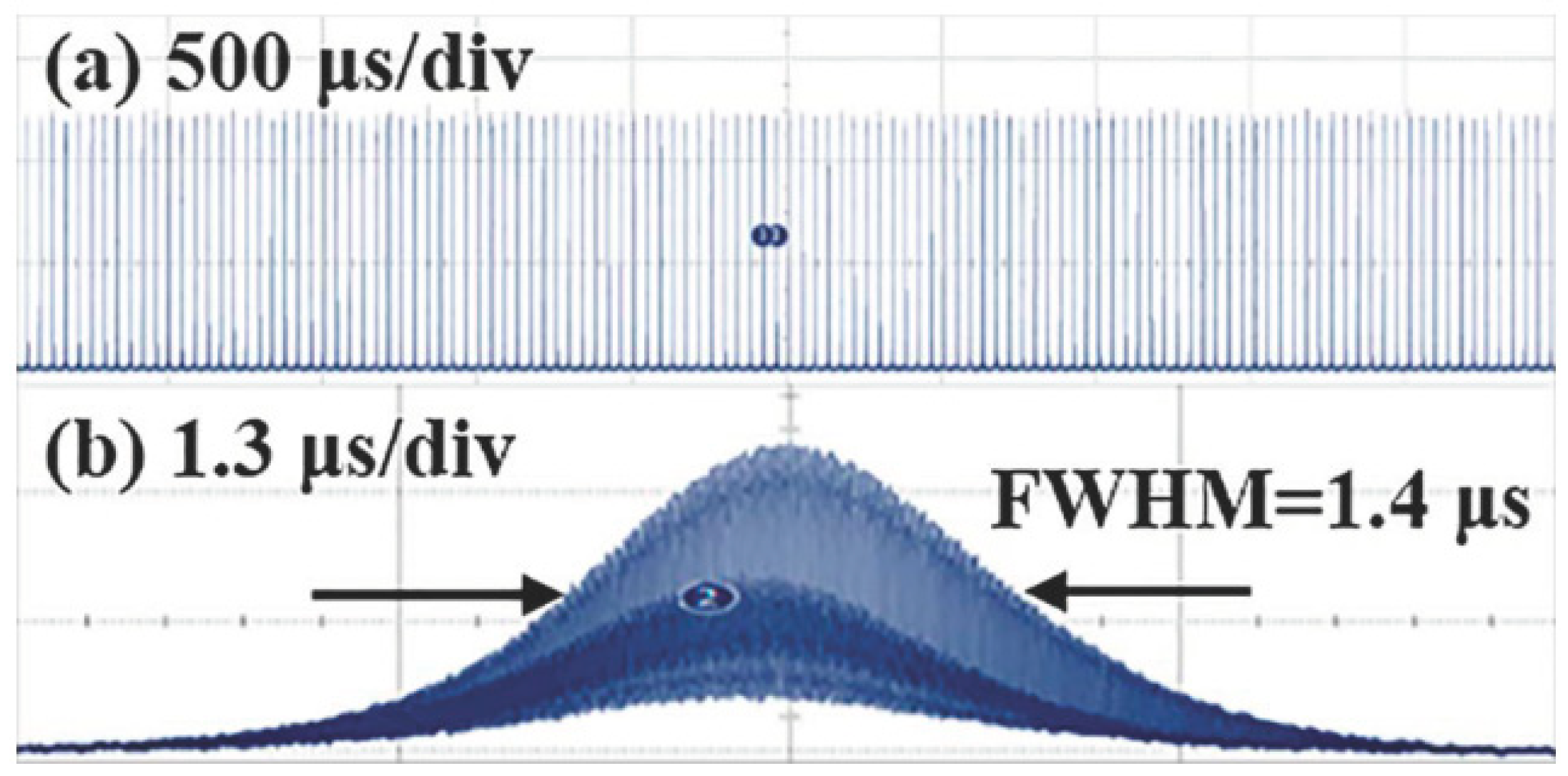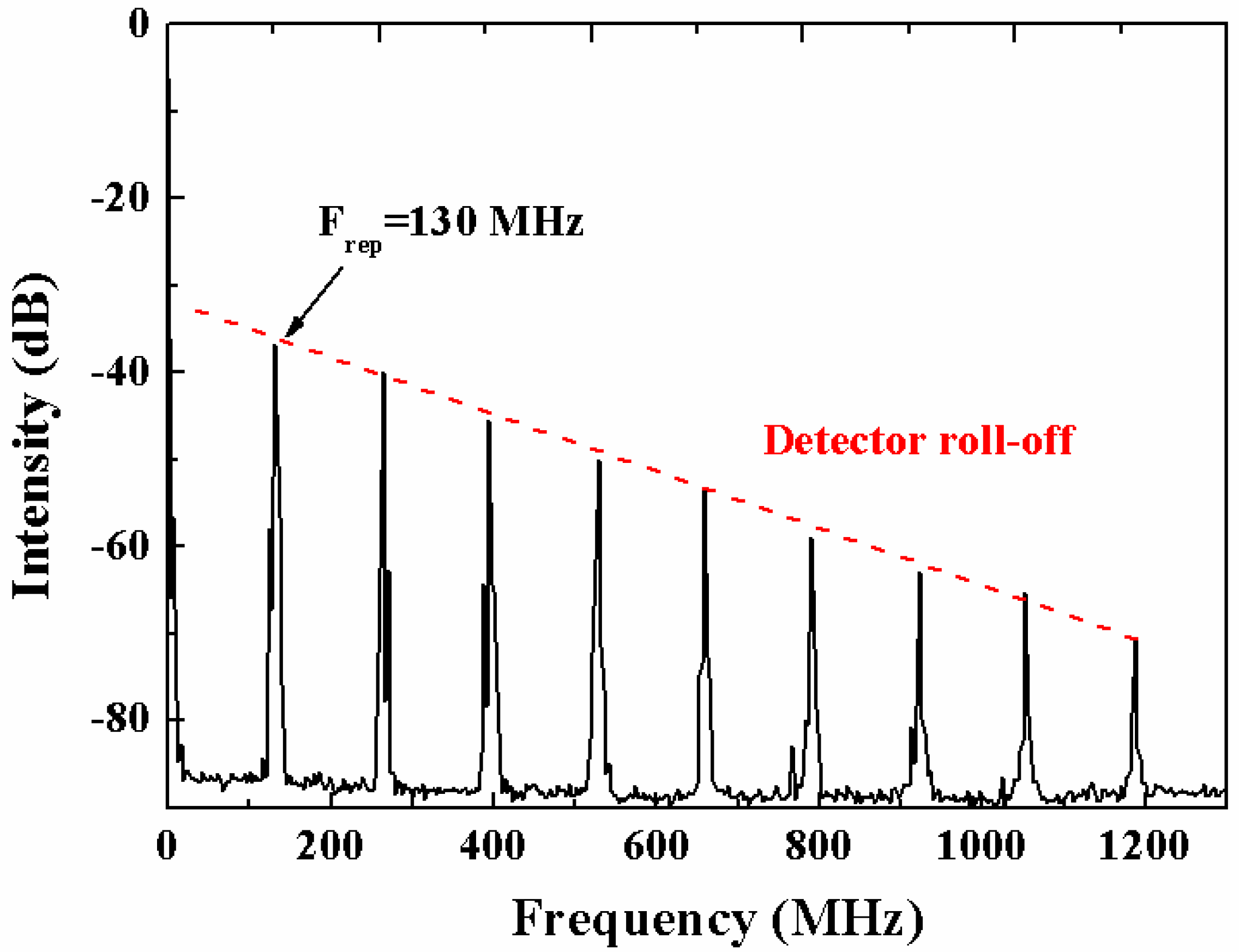1. Introduction
In recent years, laser sources operating around 3 μm have been widely studied for using in spectroscopy, differential absorption lidar, remote sensing, and laser surgery because their wavelength coincides with the strong absorption spectral region of the water, vapor and biological tissues [
1]. Optical parametric oscillation, stimulated raman scattering, and semiconductor technology can be used to access the mentioned laser radiations [
2,
3]. In terms of the cavity simplicity and the laser-output beam quality, Er
3+ doped solid-state lasers at ~3 μm are of great interest and have been widely studied utilizing the developed InGaAs laser diode emitting around 980 nm as pump sources [
4,
5,
6,
7].
Conventionally, lifetime of the upper laser level for the Er 3-μm laser transition is less than that of the terminal one. High Er
3+ ions doped concentration is highly desired to prevent the self-terminating effect of the transition of
4I
11/→
4I
13/2 and to depopulate the level of
4I
13/2 state with the concentration related up-conversion process. In YAG and YSGG hosts, for example, the optimized doping levels for efficient Er 3-μm laser operation are as high as 50 at.% and 30 at.% [
4]. In order to obtain a higher laser output power with such gain medium, evaluation of the thermal effect and the laser efficiency is necessary [
5,
6]. Therefore, the recently developed Er:Y
2O
3 ceramics with a relatively lower concentration for efficient 3-μm laser operation have gained considerable attention because of their lower phonon energy, larger cation density, and higher thermal conductivity. The transmission spectrum of the Er:Y
2O
3 ceramics and the transmission level at the lasing wavelength have already been reported in ref. [
8]. Recent studies have shown that the Er:Y
2O
3 ceramic is a promising laser gain medium for high power 3-μm continuous-wave (CW) and nanosecond pulsed operations [
7,
8,
9].
Large amounts of energies can be released by ultrafast lasers at a short timescale, and hence this type of lasers are of great interest for some practical applications. Picosecond lasers at 3 μm can be used in minimally invasive devices for laser microsurgery [
10,
11]. Laser pulses generated from continuous-wave mode locking (CWML) have advantages of high pulse stability and low noise. While lasers in the mode of Q-switched and mode locked (QML) operation can achieve much higher pulse energy [
12]. In the past decades, the operation of QML with 3-μm solid-state lasers is conducted mostly based on Er:YAG, and its applications in microsurgery have been studied using flash-lamp-pumped scheme. Normally, the Q-switched envelop has the repetition frequency of 1 Hz~2 Hz due to the inherent severe thermal effect [
13,
14]. In the wavelength region of 3-μm, Er
3+ doped thermally advanced sesquioxides should be an alternative option for short pulses laser generation with high power and repetition rate. In addition, the relatively large emission cross sections should enable a reduced threshold for picosecond pulse generation in mode locked mode of operation [
15,
16].
We report in this paper the realization of stable Q-switched and mode-locked operation of an 2.7 μm Er:Y2O3 ceramic laser pumped by a high brightness, linearly polarized Yb-fiber source at 976 nm and using a semiconductor saturable mirror. The Er:Y2O3 ceramic sample is home-developed and over 92 mW of average output power is generated. The mode-locked pulses embedded inside Q-switched envelopes of ~1.2 μs width have a modulation depth of 100% and repetition frequency of 130 MHz. Repetition rates of the Q-switched pulse envelope are tunable from 5.1 kHz to 29 kHz with the width varying from 2.7 μs to 1.2 μs via varying the incident pump power. This is the first report, to the best of our knowledge, on mode locked operation of Er3+-doped sesquioxide at 2.7 μm.
2. Experimental Details
Figure 1 schematically shows the experimental setup of the QML Er:Y
2O
3 ceramic laser. A home-developed Er:Y
2O
3 ceramic sample with the doping concentration of 7 at.% was cut into the size of 2 mm × 3 mm × 12.5 mm and polished in Brewster angle to reduce the Fresnel reflection. Single-pass absorption of the sample for the 976 nm pump light was ~90%. A 10 W single-mode Yb-fiber laser at 976 nm (linewidth ~0.1 nm) is utilized to provide high intensity pump. The fiber laser output has a collimated beam of ~750 μm diameter with a beam quality factor (M
2) of ~1.05 and a polarization extinction ratio of >99.9:1. An isolator was built in the collimating laser head to avoid the feedback of the pump light. The fiber output beam was first expanded with a 1:4 telescope system, comprising two plane-convex lens of 50 mm (F1) and 200 mm (F2) focal length, to ~3 mm diameter. It was then focused into the Er:Y
2O
3 ceramic by a 75 mm focal length lens. It was estimated that the pump laser beam diameter at the center of the gain medium was ~105 μm in the sagittal and ~120 μm in the tangential plane. The polarization direction of the pump light was adjusted using a half-wave plate (HWP) so as to match the Brewster-angle-cut surface of the gain medium. For efficient heat removal, the Er:Y
2O
3 ceramic wrapped with indium foil was mounted inside water-cooled copper with a maintained temperature of ~10 °C. The radius of curvature of plane-concave mirrors R
1, R
2, and R
3 were 100 mm, 100 mm, and 50 mm, respectively. The plane-concave mirrors were all coated with the reflectivity of >99.8% at 2650–2950 nm and the transmission of >97% at 965–980 nm for filtering out unabsorbed pump light and avoiding adverse effect on the semiconductor saturable absorber (SESAM). The transmittance of the output coupler was 1% in the 2650–2950 nm wavelength range. The physical length of the z type resonator was ~1.1 m in total, corresponding to a round-trip repetition rate of ~130 MHz. In the gain medium, the cavity mode diameter was estimated to be ~140 and ~90 μm in the tangential and sagittal plane, and ~50 μm on the SESAM surface, respectively. The SESAM (BATOP, SAM-2800-3-10 ps, Jena, Germany) was designed for operating in the 2700–2900 nm wavelength range and used as a high reflective end-mirror. Its modulation depth and saturation fluence were ~2% and ~90 μJ/cm
2, respectively.
The QML pulse trains were monitored by an infrared detector (VIGO System S.A., PVM-10.6, Ozarow Mazowiecki, Poland) with a response time of 1.5 ns and a 1 GHz digital oscilloscope (Keysight, DSO-S 104A, Santa Rosa, CA, USA). An optical spectrum analyzer (Thorlabs, OSA 205, Newton, NJ, USA) with the resolution of ~130 pm at 3 μm was used to recorded the output spectra. A 3 GHz spectrum analyzer (Agilent, N9320B, Santa Clara, CA, USA) with a resolution bandwidth (RBW) of 10 Hz was used to analyzed the radio frequency (RF) spectrum.
3. Results
As a comparison, by replacing the SESAM with a dichroic mirror high-reflection coated in the 2600–3000 nm, lasing characteristics of the CW mode of operation were first evaluated. The threshold was ~0.58 W, and 111 mW of 2.7 μm laser output was achieved at the pump power of 7.5 W, as shown in
Figure 2. With the SESAM replacing the cavity end mirror, the laser threshold was reached at the increased pump power of 0.62 W and laser oscillation in the QML mode is realized. At a pump power of 7.5 W, ~92 mW of average output power was measured (see
Figure 2), which corresponds to a conversion efficiency of 82.9% from the CW operation under the same operation condition.
The measured pulse repetition frequency and widths of the Q-switched envelopes versus the incident pump power are shown in
Figure 3. As expected, with the incident pump power increasing, the repetition frequency increased and the width of the Q-switched pulse envelope decreased. The repetition frequency of the Q-switched envelope increased from 5.1 to 23.8 kHz and the pulse width reduced from 2.7 to 1.4 μs as the incident pump power increasing from 1.0 to 5.0 W. Output energies of the Q-switched pulse envelops at 5.0 W of incident pump power were estimated to be ~3.11 μJ. At the pump power of 5 W, the oscilloscope trace of a typical pulse train and a single Q-switched pulse envelop of the QML laser are shown in
Figure 4. It can be seen that the Er:Y
2O
3 ceramic laser operated at a highly stable state and its pulse-to-pulse amplitude fluctuation for Q-switched envelops was estimated <5%. Mode-locking of >90% modulation depth could be observed for a wide range of pump powers from threshold to ~5 W.
QML pulse envelops with 100% modulation depth were obtained with further increasing the launched pump power. Oscilloscope trace of the mode locked pulse train lying underneath a typical Q-switched pulse envelop is shown in
Figure 5. When the incident pump power was tuned to be 7.5 W, the repetition rate and pulse width of the Q-switched envelop were 29 kHz and 1.2 μs, respectively. It is shown in
Figure 5b that stable mode-locked pluses lying underneath a Q-switched envelope have the pulse-pulse separation of ~7.7 ns, corresponding to the repetition rate of ~130 MHz, matching well with the time of the resonator roundtrip. The estimated width (FWHM) of mode locked pulses was less than 1.43 ns limited by the response time of the 3 μm detector we used (1.5 ns).
Figure 6 is the radio frequency spectrum of the QML pulses at 7.5 W of incident pump power, showing a fundamental beat signal of 130 MHz (resolution bandwidth of 1 kHz) and the signal-to-noise ratio of 45 dB, indicating stable Q-switched mode locked operation of the laser.
Figure 7 shows the output spectra in both CW and QML mode of operation. It shows that the laser wavelength is centered at 2726.5 nm, and the spectra bandwidths in QML and CW mode of operation are ~0.36 nm and ~0.2 nm, respectively, which indicates that there are more longitudinal modes oscillate in the QML operation regime.
As a criterion to achieve CW mode locking based on the saturable absorber, the intra-cavity pulse energy should satisfy [
16]:
where E
p represents the intra-cavity pulse energy, E
sat,g represents the saturable energy of the gain medium, E
sat,a represents the saturable energy of the saturable absorber, and ∆R represents the modulation depth of the saturable absorber, respectively. CW mode locking should be achievable with saturable absorbers of reduced modulation depth and unsaturable losses and with modified resonator design of further optimized beam sizes and output coupling.
